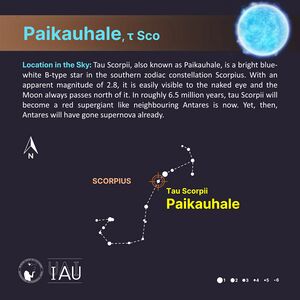Paikauhale: Difference between revisions
No edit summary |
No edit summary |
||
| (4 intermediate revisions by the same user not shown) | |||
| Line 1: | Line 1: | ||
{{DISPLAYTITLE:Paikauhale}} |
{{DISPLAYTITLE:Paikauhale}} |
||
[[File:Paikauhale profileCard SadeghFaghanpour-IAU-WGSN.jpg|thumb|Paikauhale profile card (CC BY Sadegh Faghanpour for IAU WGSN).]] |
|||
Paikauhale is a modern star name adopted by the International Astronomical Union in the IAU-Catalog of Star Names (IAU-CSN). Its origin is Hawaii'ian. It is the name of HIP 81266 (τ Sco, HR 6165) in constellation Sco. |
Paikauhale is a modern star name adopted by the International Astronomical Union in the IAU-Catalog of Star Names (IAU-CSN). Its origin is Hawaii'ian. It is the name of HIP 81266 (τ Sco, HR 6165) in constellation Sco. |
||
==Etymology and History== |
==Etymology and History== |
||
[[File:Paikauhale stickfigure SadeghFaghanpour-IAU-WGSN.jpg|thumb|Paikauhale stickfigure (CC BY Sadegh Faghanpour for IAU WGSN).]] |
|||
Au-haele, Hōkū-‘ula, and Paikauhale are documented as three stars in a line, running from north to south. Two of the most reliable sources – Mary Puku‘i and Rubellite Johnson – both identify Hōkū-‘ula as Antares (α Sco), which makes Au-haele Alniyat (σ Sco) and Paikauhale τ Sco. |
Au-haele, Hōkū-‘ula, and Paikauhale are documented as three stars in a line, running from north to south. Two of the most reliable sources – Mary Puku‘i and Rubellite Johnson – both identify Hōkū-‘ula as Antares (α Sco), which makes Au-haele Alniyat (σ Sco) and Paikauhale τ Sco. |
||
"Paikauhale" (pă'i-kă'u-hā'-le) literally translates to "to go gadding about from house to house" in the Hawaiian language, according to the Pukuʻi & Elbert Hawaiian Dictionary. |
"Paikauhale" (pă'i-kă'u-hā'-le) literally translates to "to go gadding about from house to house" in the Hawaiian language, according to the Pukuʻi & Elbert Hawaiian Dictionary<ref>Pukui & Elbert (1986). Hawaiian-English Dictionary ([https://wehewehe.org/gsdl2.85/cgi-bin/hdict?d=&l=en&e=p-11000-00---off-0hdict--00-1----0-10-0---0---0direct-10-ED--4--textpukuielbert%2ctextmamaka-----0-1l--11-haw-Zz-1---Zz-1-home---00-3-1-00-0--4----0-0-11-00-0utfZz-8-00 online]). </ref>. |
||
==Mythology== |
==Mythology== |
||
| Line 12: | Line 13: | ||
==IAU Working Group on Star Names== |
==IAU Working Group on Star Names== |
||
The name was adopted by the IAU WGSN on 2018/08/10. |
The name was adopted by the IAU WGSN on 2018/08/10. |
||
Currently, Paikauhale is a young blue-white (B-type) star at its main-sequence phase of stellar evolution. As it has a mass of 15 solar masses, it will end its life in a majestic explosion called "supernova". So, in a far future (i.e. in ~6.5 million years from now), it will become a red supergiant and look like neighbouring Antares looks now. Yet, by that time, Antares itself will have gone supernova already. |
|||
==Weblinks== |
==Weblinks== |
||
Latest revision as of 15:38, 4 September 2025
Paikauhale is a modern star name adopted by the International Astronomical Union in the IAU-Catalog of Star Names (IAU-CSN). Its origin is Hawaii'ian. It is the name of HIP 81266 (τ Sco, HR 6165) in constellation Sco.
Etymology and History
Au-haele, Hōkū-‘ula, and Paikauhale are documented as three stars in a line, running from north to south. Two of the most reliable sources – Mary Puku‘i and Rubellite Johnson – both identify Hōkū-‘ula as Antares (α Sco), which makes Au-haele Alniyat (σ Sco) and Paikauhale τ Sco.
"Paikauhale" (pă'i-kă'u-hā'-le) literally translates to "to go gadding about from house to house" in the Hawaiian language, according to the Pukuʻi & Elbert Hawaiian Dictionary[1].
Mythology
IAU Working Group on Star Names
The name was adopted by the IAU WGSN on 2018/08/10.
Currently, Paikauhale is a young blue-white (B-type) star at its main-sequence phase of stellar evolution. As it has a mass of 15 solar masses, it will end its life in a majestic explosion called "supernova". So, in a far future (i.e. in ~6.5 million years from now), it will become a red supergiant and look like neighbouring Antares looks now. Yet, by that time, Antares itself will have gone supernova already.
Weblinks
- Website of the IAU WGSN: https://exopla.net/
Reference
- References (general)
- Johnson, Mahelona and Ruggles (2015), Nā Inoa Hōkū, p. 201






